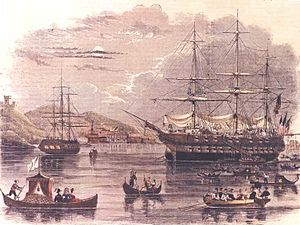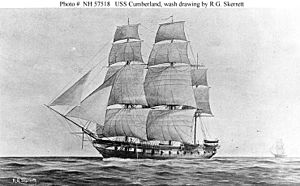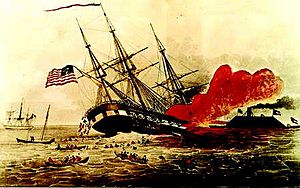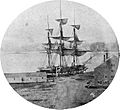USS Cumberland (1842) facts for kids

USS Cumberland
|
|
Quick facts for kids History |
|
|---|---|
| Name | USS Cumberland |
| Laid down | 1824 |
| Launched | 24 May 1842 |
| Commissioned | 9 November 1842 |
| Fate | Sunk 8 March 1862 |
| General characteristics | |
| Class and type | Raritan-class frigate |
| Tonnage | 1726 |
| Length | 175 ft (53 m) |
| Beam | 45 ft (14 m) |
| Draft | 21.1 ft (6.4 m) |
| Complement | 400 officers and men |
| Armament |
|
The first USS Cumberland was a large 50-gun sailing ship of the United States Navy. She was built to be a strong warship. Cumberland is famous for being the first ship sunk by an ironclad ship, the CSS Virginia, during the American Civil War.
Cumberland was planned way back in 1816, but it took a long time to build her. Money problems kept her from being finished quickly. Finally, in 1842, the Secretary of the Navy, Abel P. Upshur, ordered her completion. This happened because there was a worry about war with Britain.
The ship was designed by a famous American ship designer named William Doughty. Cumberland was part of the Raritan-class of frigates. Her design was based on older, successful American ships like the Constitution. Doughty wanted his frigates to have more guns than European ships. So, Cumberland was built with many guns on both her main deck and her upper deck, making her a very powerful 50-gun warship.
Contents
Early Journeys of the USS Cumberland
Cumberland was launched on May 24, 1842, from the Boston Navy Yard. Her first captain was Samuel Livingston Breese.
First Trip to the Mediterranean Sea
From 1843 to 1845, Cumberland served as the main ship for the Mediterranean Squadron. This means she was the ship where the squadron's leader, Commodore Joseph Smith, stayed. Many important officers, like Andrew Foote and John Dahlgren, served on board during this time.
The ship visited many places around the Mediterranean Sea, including Port Mahon, Genoa, Naples, and Alexandria. This trip was mostly peaceful. One interesting event was when Foote worked to stop sailors from getting a daily alcohol ration, called "grog." He believed it would help sailors be better workers. This idea later became a rule for the entire Navy in 1862.
Serving in the Mexican-American War
As Cumberland was getting ready for another trip to the Mediterranean, she was sent to Mexico instead. She became the flagship for the Home Squadron from February to December 1846 during the Mexican–American War. She helped blockade the eastern coast of Mexico.
During this time, Cumberland ran aground (got stuck in shallow water) but was freed. Her crew then helped in a raid on Tabasco. The ship needed repairs, so she went back to Norfolk. Her crew, however, stayed in Mexico and joined another ship, the Raritan. This crew later helped fight in the Siege of Veracruz.
Cumberland returned to Mexico after a ceasefire was in place. She helped American settlers who were escaping a major uprising in Yucatán. She also worked to make sure other countries like Spain and England did not interfere. The ship left the area when the war officially ended with the Treaty of Guadalupe Hidalgo.
Second and Third Trips to the Mediterranean Sea
Cumberland made two more trips to the Mediterranean Sea, from 1849 to 1851 and then starting in 1852. Important officers like John Worden, who later commanded the famous ironclad USS Monitor, served on these trips.
The main job of Cumberland on these trips was to keep America neutral during a time of trouble in Europe. She helped American diplomats and merchants. The ship visited many ports like La Spezia, Naples, and Athens.
During her third trip, Cumberland worked with the American ambassador to the Ottoman Empire, George Perkins Marsh. They helped stop Greek priests from bothering American missionaries. Cumberland also offered protection to any Americans who felt unsafe when the Crimean War was about to begin. The Sultan of the Ottoman Empire, Abdulmejid I, even invited the ship's commander and Marsh to discuss America's position in the possible war with Russia. They said America would remain neutral.
One time, while Cumberland was in Constantinople, the Turkish army accidentally fired a cannonball close to the ship during a salute. The Commodore joked, "Send an Officer in a boat and ask whether they want that salute returned the way they gave." A Turkish officer quickly apologized, saying it was a mistake.
The third trip was very long, lasting three years, because there were not enough sailors to send a replacement ship. Cumberland finally returned home to the Charlestown Navy Yard in June 1855.
Changes to the Ship: Becoming a Sloop-of-War
From 1855 to 1857, Cumberland was changed at the Charlestown Navy Yard. This process was called "razeeing." It meant removing the upper deck guns and lowering the ship's sides. This made Cumberland lighter and a bit faster. It also meant she needed fewer crew members and supplies.
The Navy also gave her new, more powerful guns. On her upper deck, she got two large X-inch Dahlgren guns. On her main gun deck, she had twenty IX-inch Dahlgren guns. These changes gave Cumberland a longer life in the Navy, even as new steam-powered ships were being built.
Patrolling for Slave Trade
From 1857 to 1859, Cumberland sailed off the coast of Africa. She was the main ship for the African Squadron, whose job was to stop the slave trade. Like other U.S. Navy ships in Africa, Cumberland hired local Africans called Krooman to help as guides and interpreters. The ship's doctors had to deal with health issues, including an outbreak of smallpox.
Cumberland stopped and inspected many merchant ships. Her crew almost captured one ship, the Cortez, because they found items used for slave trading. However, they decided not to seize it, possibly because it was hard to prove guilt in court without very strong evidence. The Cortez was later captured by a British ship.
Besides patrolling, Cumberland also supplied the other ships in the squadron and acted as a diplomat along the long African coastline.
Return to Home Waters
After her time in Africa, Cumberland became the flagship of the Home Squadron in 1860. She made a trip to Vera Cruz, Mexico, which was in the middle of a civil war. Soon after, she was called back to Hampton Roads, Virginia, as problems in the United States grew worse.
The American Civil War and Final Battle
When the American Civil War began, Cumberland was at the Gosport Navy Yard. Her crew was ordered to collect or destroy U.S. government property, including small arms and possibly gold. They were also told to disable 3,000 guns at the Navy Yard, which was impossible for only 100 sailors to do in a few hours.
On April 20, 1861, Cumberland was towed out of the yard by the steamship Pawnee. She escaped destruction while other Union ships were sunk or burned to prevent them from being captured by Confederate forces. She then went to Boston for repairs. One of her large guns was replaced with a powerful "70-pounder" rifle.
Cumberland returned to Hampton Roads and joined the Union blockade. She fought in several small battles and captured many ships. She also helped capture the forts at Cape Hatteras.
On March 8, 1862, Cumberland was rammed and sunk by the Confederate ironclad CSS Virginia (which used to be the USS Merrimack). This battle happened at Newport News, Virginia, and is known as the first day of the Battle of Hampton Roads. This battle was a huge moment in naval history. It showed that powerful, armored, steam-powered ships were much better than older wooden sailing ships. Even though Cumberland sank, she caused a lot of damage to Virginia, breaking off two of her guns and her ram. Many people believed Cumberland did more damage to Virginia than the Union's own ironclad, the Monitor, which fought Virginia the next day.
One of the brave men who died on Cumberland was Navy chaplain John L. Lenhart. He was the first Navy chaplain to die in battle. The battle was even remembered in a poem called On Board the Cumberland.
The Wreck of Cumberland Today
After she sank, Cumberland became an important underwater site. The government quickly started looking for valuable items from the shipwreck.
People tried to salvage the ship for many years. One person, George Benjamin West, described how divers tried to find $40,000 in gold that was said to be in the paymaster's room. Divers had to work in the dark, muddy water, and it was very dangerous.
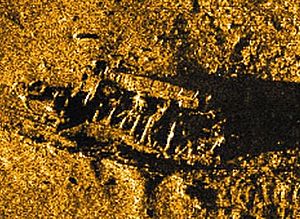
Even in the early 1900s, parts of the ship were still being recovered. In 1909, part of Cumberland's anchor chain was found and sent to a museum.
In 1981, a team of archaeologists found the wrecks of Cumberland and another ship, the CSS Florida. They found many artifacts, including parts of the ship, old medicine bottles, a ship's bell from Cumberland, and cannon parts. Most of these items are now on display at the Hampton Roads Naval Museum in Norfolk, Virginia.
Cumberland is still a shipwreck today, protected by several U.S. laws. These laws mean that the U.S. Government owns the ship and its contents. Many expeditions have explored the wreck. Some have been against the law, and artifacts were taken by federal agents. However, many artifacts from both legal and illegal expeditions are now at the Hampton Roads Naval Museum.
The wreck of Cumberland lies facing west to east, with the front of the ship slightly raised from the seabed in Hampton Roads.
Gallery


